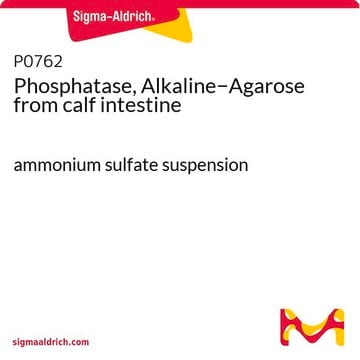API-RO
Roche
Alkaline Phosphatase (AP)
grade I, from calf intestine
Sinónimos:
AP, Alkaline Phosphatase
About This Item
Productos recomendados
biological source
bovine (calf) intestine
Quality Level
form
suspension
packaging
pkg of 1,500 U (10108138001)
pkg of 7,500 U (10108146001)
manufacturer/tradename
Roche
optimum pH
8.0-10.5
absorption
7.6 at 278 nm (10 mg AP/ml)
storage temp.
2-8°C
General description
Alkaline phosphatase catalyzes the removal of phosphate group from various compounds that are phosphorylated. It hydrolyzes 5′-monophosphate groups from both DNA and RNA. It can also hydrolyze 5′-diphosphate and 5′-triphosphate groups from RNA.
Specificity
Denaturation is dependent on protein concentration - using less than 10 U/ml (0.1 mol/l glycine buffer, pH 10.5, 1 mmol/l MgCl2 and 0.1 mmol/l ZnCl2), AP is inactivated by a 10 minutes incubation at 65 °C.
Application
Quality
Sequence
In some mammals (e.g., humans), there are at least 3 distinguishable isoenzymes: the intestinal, the placental and the form found in bone/liver/kidney.
Unit Definition
AP activity is not expressed in Armstrong units; a conversion factor for international units is not known.
Approx. 3.8 U (grade I AP) or 4.0 U (grade II AP) [+37 °C, 4-NPP as substrate, diethanolamine as buffer, pH 9.8] = 1 U [+25 °C, 4-NPP as substrate, glycine as buffer, pH 10.5].
Biochemica Information. 87 (grade I AP) :
1.0 U [+37 °C, QC assay conditions] = 0.79 U [+30 °C, QC assay conditions] = 0.57 U [+25 °C, QC assay conditions]
Physical form
Preparation Note
- Activator: Divalent metal ions (Mg2+, Co2+, Mn2+)
- Amino alcohols (2-amino-2-methyl-1-propanol, diethanolamine)
Note that high concentrations of amino alcohols can as well act as competitive inhibitors (e.g., monoethanolamine in diethanolamine).
Storage conditions (working solution): The suspension is offered at a c= approx. 5 mg/ml.
If this suspension is diluted only 5 to 10-fold with further 3.2 M ammonium sulfate solution, 1 mM MgCl2, 0.1 mM ZnCl2, pH approx. 7, we would expect from general experience that a stability for some weeks might be given provided it is stored at 4 °C (no guarantee!).
Other Notes
Storage Class
12 - Non Combustible Liquids
wgk_germany
WGK 1
flash_point_f
does not flash
flash_point_c
does not flash
Certificados de análisis (COA)
Busque Certificados de análisis (COA) introduciendo el número de lote del producto. Los números de lote se encuentran en la etiqueta del producto después de las palabras «Lot» o «Batch»
¿Ya tiene este producto?
Encuentre la documentación para los productos que ha comprado recientemente en la Biblioteca de documentos.
Los clientes también vieron
Protocolos
Alkaline phosphatase (AP) is a non-specific phosphomonoester hydrolase that catalyzes the hydrolysis of a wide variety of organic monophosphates.
Nuestro equipo de científicos tiene experiencia en todas las áreas de investigación: Ciencias de la vida, Ciencia de los materiales, Síntesis química, Cromatografía, Analítica y muchas otras.
Póngase en contacto con el Servicio técnico






